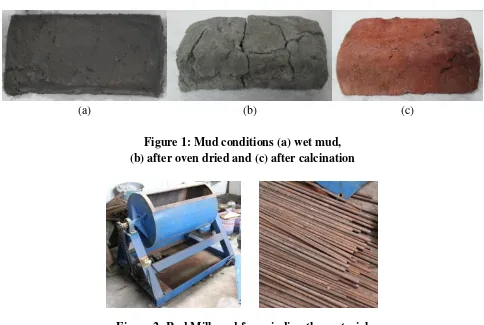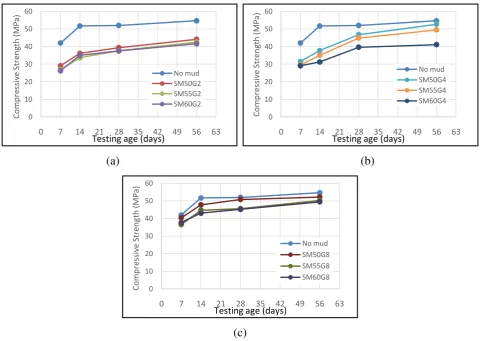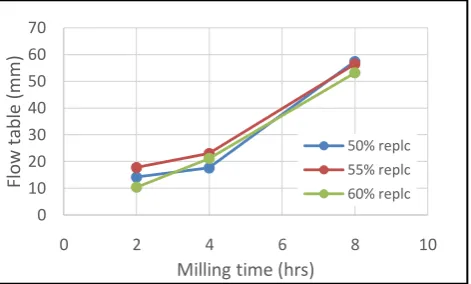1
ON THE DEVELOPMENT OF HIGH VOLUME VOLCANIC MUD
MORTAR AND CONCRETE
ANTONI1*, D. HARDJITO1†, L. CHANDRA1 and T. H. WIDODO1 1
Department of Civil Engineering, Petra Christian University, Indonesia
ABSTRACT
A mud volcano has been emerging since May 2006, in Sidoarjo, Indonesia, as a result of faulty in oil drilling. Since then, the mud has submerged more than 700 hectares of productive land, housing and industrial areas and infrastructures. To date, the eruption still continues, and there is no sign that it will end in the near future. The contents of mud are predominantly SiO2, Al2O3 and Fe2O3 in crystalline form, with the total amount more than 80%. This paper reports an attempt to utilize the volcanic mud in high volume volcanic mud mortar and concrete. After pre-treatment in the form of calcinations and grinding, the volcanic mud was found to be reactive. Treated volcanic mud in the amount up to 60% of the total cementitious material was utilized to produce mortar and concrete. The main variables were the fineness of the treated mud and the amount of the mud. It was found that the particle size of the treated mud plays an important role on the properties of mortar and concrete, whereby the finer provides the better properties. With 60% usage of volcanic mud of the total mass of cementitious material, the strength activity index (SAI) of the mortar at the age of 7, 14, 28 and 56 days were found to be more than 80%. This study reveals the potential of volcanic mud from Sidoarjo, East Java, Indonesia, to be used as pozzolanic material in high volume volcanic mud mortar and concrete.
Keywords: Volcanic Mud, Strength Activity Index, Calcinations, High Volume, Particle Size.
1. INTRODUCTION
The mud volcano in Sidoarjo, Indonesia has been in its seventh year of eruption, causing a very destructive impact to the surrounding population; in the economic, social and many other sectors. Various attempts have been made to end the disaster; however all have yet to deliver any promising solution. The mud volcano discharged approximately 180,000 m3 of mud daily, during its peak in 2007, and it still continues until presently, with daily eruption of 10,000 m3 (Hardjito et al. 2013). Till date, the mud volcano has covered area of no less than 700 hectares, surrounded by cover dam about 12 m in height. This enormous amount of material has not been used, and it is considered only as waste material. Initial attempt to use the volcanic mud was not successful, especially due to the inert condition of the mud. The inclusion of volcanic mud into concrete mixture could only lead to lower workability and significant loss of strength.
From previous research, it was found that calcinations at temperature higher than 700°C and milling
the mud until its particle sizes smaller than 150μm, was able to activate the volcanic mud and hence
*
Corresponding author: Email: [email protected]
†
2
improve its reactivity of otherwise an inert materials (Nuruddin et al. 2010; Antoni et al. 2012). It was shown that the mud could be used as partial substitute for the Portland cement with only slightly lower compressive strength. Hardjito et al. (2012) reported their success in using semi high volume of Sidoarjo volcanic mud up to 40% of cement replacement by using smaller particle size of the milled mud (<63μm). In this study, further attempt to utilize the volcanic mud in a higher volume as cement replacement has been carried out. Cement replacement with mud, up to 60% by mass, was evaluated to determine its effect on the physical and mechanical properties of mortar and concrete. The effect of the particle size on the reactivity of mud and the workability of the fresh mixture were also investigated and reported in this paper.
2. MATERIALS AND METHODS
2.1. Heat treatment and milling
The treatment process was divided into several steps, as follows: molding the wet mud into rectangular brick form, then drying it in the oven at temperature of 110°C for one day, followed by at temperature 200°C for another day to reduce any smoke that could arise during heating. Calcination was performed at local brick manufacturer. The maximum temperature measured for the process was 945°C. The temperature for the calcination process was increased gradually to reach a peak temperature in about 36 hours, kept the temperature for about 5 hours, and then cooled down slowly to room temperature that took about 12 hours. Figure 1 shows the volcanic mud material in different heat treatment stages.
Figure 1: Mud conditions (a) wet mud, (b) after oven dried and (c) after calcination
Figure 2: Rod Mill used for grinding the material
The treated mud was then milled to obtain particle fineness of smaller than 63μm. Rod mill used to
mill the treated mud is shown in Figure 2. Milling was performed utilizing mash force between the (c)
3
iron bars in the steel drum and the mud material. The drum was rotated at constant speed for the duration of 2, 4 and 8 hours to obtain different particle fineness.
Particle size analysis was conducted on the milled materials and the results are shown in Error!
Not a valid bookmark self-reference.. Longer milling time resulted in a finer material as shown in
the table, where D50 of the material was shown to reduce from 15μm to 8μm with the addition of 2 hours processing. However, additional 4 hours of processing only reduced the D50 into about 6μm. Specific Surface Area (SSA) of the material increased with the increase of milling time. SSA of 1.30 m2/g, 2.24 m2/g and 2.58 m2/g were recorded for 2 hours, 4 hours and 8 hours milling, respectively.
Table 1: Particle Size Distribution for the milled volcanic mud
Milling Duration D10 D50 D90 Specific Surface Area
(μm) (μm) (μm) (m2/g)
2 hours 1.832 15.180 475.604 1.30 4 hours 0.937 7.991 114.402 2.24 8 hours 0.768 6.632 342.661 2.58
2.2. Materials
The results of an X-ray fluorescence (XRF) analysis conducted on calcined mud are shown in Table 2. For comparison, the XRF analysis of previous research was tabulated also (Nuruddin et al. 2010). It was shown that there was similar oxide composition of the mud taken from different period of time. The silicon oxide, alumina oxide and ferrous oxide were the highest components in the mud. According to ASTM C618 (2005), a material is classified as pozzolanic material if the total content of compounds SiO2, Al2O3 and Fe2O3 is minimum 70%, mass loss due to burning is maximum 10% and SO3 content is maximum of 4%. With this definition, the Sidoarjo mud after treatment can be classified as a pozzolanic material.
Table 2: XRF analysis result of Sidoarjo Mud Volcano
Oxide
4
2.3. Specimens and testing
Reactivity of the treated Sidoarjo mud was investigated on mortar cubes of 5×5×5 cm3. The binder to sand ratio by mass was kept constant at 1:2.29, while the water to binder ratio was 0.35 by mass. The binder or cementitious materials comprised of a combination of cement and treated volcanic mud. High volume of cement replacement was the main focus of this study. Therefore, the cement replacement was set at 50%, 55% and 60% by mass, while no-mud specimens were made for a reference or control. A polycarboxylate-based superplasticizer was added at 1.5% of binder mass to increase the workability of mortar mixes.
One concrete mix was also made to verify the result, with the binder or cementitious content was set at 423 kg/m3, sand at 910 kg/m3, and course aggregate at 986 kg/m3. The same water to cement ratio of 0.35 was used and 0.4% superplasticizer was added for good workability.
Compressive strength test was conducted on age 7, 14, 28 and 56 days with three specimens for each age. For each mortar mixture, flow table test was conducted according to ASTM C1437 (2007). Curing of the mortar specimens were conducted by immersing in water and taken out one day before the compressive testing. The Strength Activity Index (SAI) calculated as the ratio of compressive strength of mortar or concrete containing high volume of pozzolanic material and the ones containing no pozzolanic material to determine the reactivity of the cement substituting material.
3. RESULTS AND DISCUSSIONS
3.1. Activation of mud by milling
Table 3: Compressive Strength of the mortar cube, percentage of 28 days strength and the Strength Activity Index
7 days 14 days 28 days 56 days SAI 28 days SAI 56 days
Code MPa % MPa % MPa % MPa % % %
No mud 42.00 80.77 51.73 99.48 52.00 100.00 54.67 105.13 100.00 100.00 SM50G2 29.07 73.91 36.13 91.86 39.33 100.00 44.13 112.20 75.63 80.72 SM55G2 26.93 71.62 33.60 89.36 37.60 100.00 42.53 113.11 72.31 77.79 SM60G2 26.27 70.11 35.07 93.59 37.47 100.00 41.60 111.02 72.06 76.09 SM50G4 31.47 67.24 37.73 80.62 46.80 100.00 52.67 112.54 90.00 96.34 SM55G4 29.60 66.07 35.07 78.28 44.80 100.00 49.47 110.42 86.15 90.49 SM60G4 29.07 73.41 31.20 78.79 39.60 100.00 41.07 103.71 76.15 75.12 SM50G8 40.40 79.53 47.73 93.96 50.80 100.00 52.20 102.76 97.69 95.48 SM55G8 36.53 80.11 44.67 97.96 45.60 100.00 50.27 110.24 87.69 91.95 SM60G8 37.73 83.47 43.07 95.29 45.20 100.00 49.47 109.45 86.92 90.49
5
The variation of the cement replacement ratio by mud on the compressive strength is not so influencing compared to the milling time. Similar compressive strength was obtained for mortar specimens containing mud of the same grinding condition with different cement replacement ratio. This is understandable since the difference in replacement ratios is small. The Strength Activity Index (SAI) is also shown in Table 3 for 28 days and 56 days compressive strength of the mortar cubes. At 56 days, all mixes have SAI above 75%. On the other hand, at 28 days strength mortar with 55% and 60% cement replacement with calcined mud, milled for 2 hours time, do not comply with this requirement.
(a) (b)
(c)
Figure 3: Compressive Strength of the mortar with different percentages of cement
replacement and milling time of mud of (a) 2 hours, (b) 4 hours and (c) 8 hours
6
Table 4 shows the compressive strength concrete utilizing the treated volcanic mud milled for 8 hours. Compressive strength of 37.63 MPa was achieved for concrete specimen with 50% cement replacement using the treated mud. The Strength Activity Index is slightly lower than the mortar specimen, but it still shows a high percentage more than 75%, showing that the treated mud has an excellent pozzolanic reactivity for making high volume volcanic mud concrete.
Table 4: Compressive Strength and SAI of concrete specimen
Age 7 days 14 days 37 days 56 days
3.2. Effect of particle size on workability
The result of the flow table test is shown in Figure 4. It seems that there is significant increase in the workability of mortar with the increase of milling time of mud. On the contrary to common understanding that mortar containing finer particle materials usually shows lower workability, the use of treated volcanic mud causes higher workability when its particle is finer. This result could be due to larger particle size of the mud have greater friction within the mortar mixture and resulting in lower workability. In addition, the particle shape after milling also might influence the workability of the mortar mixes.
Figure 4: Increase of the mixture workability with increase of milling time
4. CONCLUSIONS
From the current study, the following conclusions are drawn:
1. It is possible to use high volume of treated volcanic mud to produce a good quality mortar and concrete. The treated volcanic mud can replace at least up to 60% cement by mass with Strength Activity Index (SAI) higher than 75%.
2. Longer milling time increases the treated volcanic mud particle fineness and thus increases its reactivity. Using volcanic mud milled for 8 hours with SSA 2.58 m2/g ends up with SAI of more than 90% after 56 days.
3. Finer particle size of the treated volcanic mud increases the workability of the mixture.
7
5. ACKNOWLEDGMENTS
The authors gratefully acknowledge The Directorate General for Higher Education, Ministry of Education and Culture, Indonesia, who provided the research grant through the ‘Hibah Penelitian Unggulan Perguruan Tinggi’ scheme in 2012 and 2013.
REFERENCES
Antoni, Geman R, Tjondro RT, Anggono J and Hardjito D (2013). Effects of calcination temperature of LUSI mud on the compressive strength of geopolymer mortar. Advanced Materials Research. 626. pp 224-228.
Antoni, Hardjito D, Wibowo F, & Chandra, N.W.(2012). Influence of heat treatment temperature, particle fineness, and replacement ratio of sidoarjo mud as pozzolanic material. Proceedings of the 5th international conference of Asian Concrete Federation. ACF2012-0046.
ASTM C 618-05. (2002). Standard Specification for Coal Fly Ash and Raw or Calcined Natural Pozzolan for Use in Concrete. ASTM International.
ASTM C 1437-07 (2007). Standard test method for flow of hydraulic cement mortar. ASTM International
Hardjito D, Antoni, Wibowo GM and Christianto D (2012). Pozzolanic activity assessment of LUSI (LUmpur SIdoarjo ) mud in semi high volume pozzolanic mortar. Materials, 5, 1654-1660.




